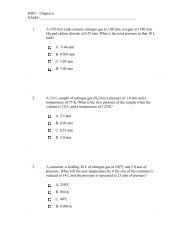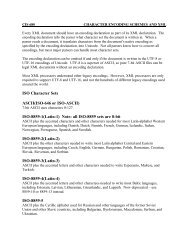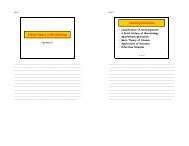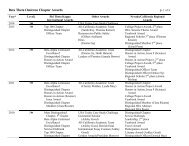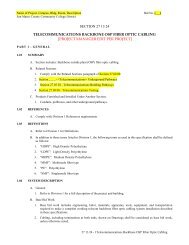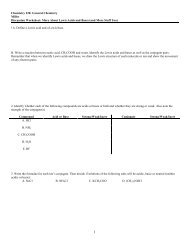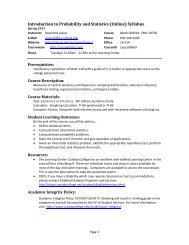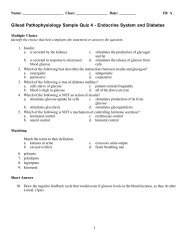Physics 100: Homework Assignment #3
Physics 100: Homework Assignment #3
Physics 100: Homework Assignment #3
You also want an ePaper? Increase the reach of your titles
YUMPU automatically turns print PDFs into web optimized ePapers that Google loves.
<strong>Physics</strong> <strong>100</strong>: <strong>Homework</strong> <strong>Assignment</strong> <strong>#3</strong><br />
Due on Friday, February 9at the Beginning of Class<br />
Instructor: Nathan Bramall Lecture: MWF 9:10 - 10:00<br />
Phone: (650) 378-7301 x 19227 Room 36-109<br />
Email: bramalln@smccd.edu Office Hours: Th. 11:00 a.m. to noon<br />
Office: 36-105F Web Page: http://smcweb.smccd.net/accounts/bramalln/<br />
Note: you may use your own paper to write out your answers if there is<br />
not enough room on this hand-out (it was not designed for such a purpose).<br />
Remember also to show all of your work on any calculations!<br />
Section 1. Warm-up! Fill-in-the-Blanks (1 pt each)<br />
1. An object falling at its terminal speed (is/isn’t) in a state of free-fall.<br />
2. A Space Elephant exploring the deep outer regions of space where there is very little gravity has just<br />
as much as it does on Earth, but much less .<br />
3. The acceleration vector of an object points in the (same/ opposite/ different) direction<br />
as the the net force acting on the object.<br />
4. The acceleration of a falling object that has reached its terminal velocity is equal to .<br />
5. The two principle factors that affect the force of air resistance on a falling object are<br />
and<br />
of the object.<br />
6. An apple weighs 1 N. Therefore, its mass is .<br />
7. The acceleration of a 300,000 kg jumbo jet just before takeoff when the thrust on the aircraft is<br />
120,000 N is .<br />
8. When a parachutist falls through the sky at constant velocity, he feels the upward tug on on his<br />
harness from the parachute and the downward pull due to gravity. In this the upward force is<br />
/,(equal to/ less than/ greater than) the force of gravity.<br />
9. As a parachutist falls, but before she reaches terminal velocity, her speed is (increasing/<br />
decreasing/ remains the same) while her downward acceleration is<br />
(increasing/ decreasing/<br />
remains the same).<br />
Section 2. Short Answer Questions (2 pts. each)<br />
10. If you push a crate with a force of 250 N across the floor in a straight line at a constant speed, (A)<br />
is the crate in equilibrium? (B) Is friction acting on the crate, and if so, how much force and in what<br />
direction is it acting?<br />
11. Consider a heavy crate sitting on a level floor. You push against it with a force of 300 N, but you’re not<br />
strong enough to move it (i.e. its acceleration and speed both remain zero). As you push against the<br />
crate, (A) what is stopping you from moving it? (B) How much force is this something providing, and<br />
in what direction? After you push on the crate for a few minutes, you tire out a bit and are only able<br />
to push with a force of 200 N. (C) Will the crate begin moving, now? If not, (D) what is preventing<br />
the crate from moving and (E) how much force is it providing and in what direction?<br />
<strong>Physics</strong> <strong>100</strong> <strong>Homework</strong> <strong>Assignment</strong> <strong>#3</strong> Spring 2007<br />
Page 1 of 2
12. Discouraged from your experience in Problem 11, you find a smaller crate, also on a level surface, that<br />
you can push. You begin pushing on it. You push harder and harder. Suddenly, it begins to move and<br />
you find that to keep it moving at a constant velocity, you don’t have to push as hard on it as you did<br />
to start it moving. Why is this so?<br />
13. If the net force on an object is suddenly tripled, (A) will the magnitude of its acceleration increase or<br />
decrease and (B) by how much? If the mass of a block accelerating horizontally across the floor were<br />
to somehow triple suddenly while the net force remained constant, (C) would its acceleration increase<br />
or decrease and (B) by how much (assume the net force acting on it does not change)?<br />
14. (A) Why does a heavy parachutist fall faster than a light parachutist if they are using identical parachutes?<br />
(B) Does this contradict Galileo’s finding that objects fall at the same speed regardless of<br />
mass?<br />
15. (A) What contains more apples: a 1 lb bag of apples on Earth, or a 1 lb bag of apples on the Moon?<br />
(B) What contains more apples: a 1 kg bag of apples on Earth, or a 1 kg bag of apples on the Moon?<br />
16. While in an orbiting space shuttle, you are handed two identical boxes, one filled with sand and the<br />
other filled with feathers. How can you determine which is which without opening the boxes?<br />
17. You and a friend are trying to push a crate across a flat floor. The crate is too small for both of you to<br />
push on it from one side, but it is heavy so it isn’t quite possible for just one of you to push it due to<br />
friction. You play rock-paper-scissors and determine that your friend will be the unlucky one to push<br />
the crate. Your friend suggest that you get in the front and pull up on the crate. Even though it’s too<br />
heavy for you to lift off of the floor, why would this help? (Don’t ask me why he doesn’t ask you to<br />
pull on the crate...).<br />
18. What is the greatest acceleration a runner can muster if the friction between her shoes and pavement<br />
provides a force equal to 75% of her weight?<br />
<strong>Physics</strong> <strong>100</strong> <strong>Homework</strong> <strong>Assignment</strong> <strong>#3</strong> Spring 2007<br />
Page 2 of 2



